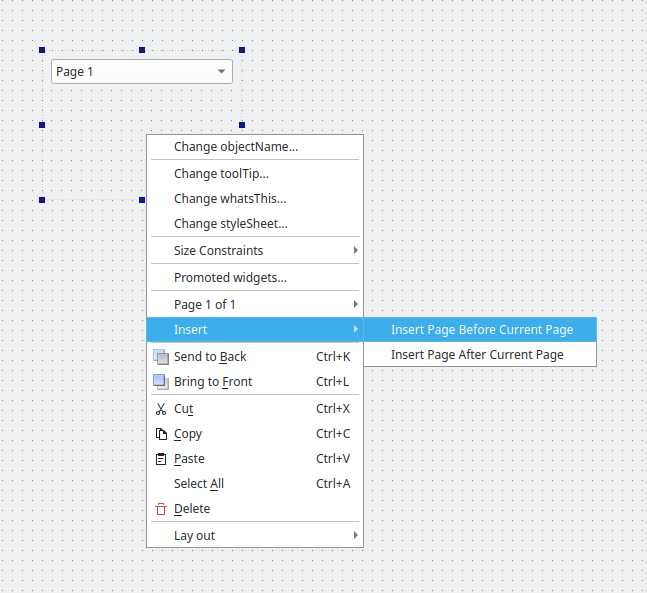QDesignerContainerExtension#
The QDesignerContainerExtension class allows you to add pages to a custom multi-page container in Qt Designer’s workspace. More…
Synopsis#
Virtual functions#
def
addWidget(widget)def
canAddWidget()def
canRemove(index)def
count()def
currentIndex()def
insertWidget(index, widget)def
remove(index)def
setCurrentIndex(index)def
widget(index)
Note
This documentation may contain snippets that were automatically translated from C++ to Python. We always welcome contributions to the snippet translation. If you see an issue with the translation, you can also let us know by creating a ticket on https:/bugreports.qt.io/projects/PYSIDE
Detailed Description#
Warning
This section contains snippets that were automatically translated from C++ to Python and may contain errors.

QDesignerContainerExtension provide an interface for creating custom container extensions. A container extension consists of a collection of functions that Qt Designer needs to manage a multi-page container plugin, and a list of the container’s pages.
Warning
This is not an extension for container plugins in general, only custom multi-page containers.
To create a container extension, your extension class must inherit from both QObject and QDesignerContainerExtension . For example:
class MyContainerExtension(QObject, public QDesignerContainerExtension Q_OBJECT Q_INTERFACES(QDesignerContainerExtension) # public MyContainerExtension(MyCustomWidget widget, parent = 0) count = int() widget = QWidget(int index) currentIndex = int() def setCurrentIndex(index): def addWidget(widget): def insertWidget(index, widget): def remove(index): # private myWidget = MyCustomWidget()
Since we are implementing an interface, we must ensure that it’s made known to the meta object system using the Q_INTERFACES() macro. This enables Qt Designer to use the qobject_cast() function to query for supported interfaces using nothing but a QObject pointer.
You must reimplement several functions to enable Qt Designer to manage a custom multi-page container widget: Qt Designer uses count() to keep track of the number pages in your container, widget() to return the page at a given index in the list of the container’s pages, and currentIndex() to return the list index of the selected page. Qt Designer uses the addWidget() function to add a given page to the container, expecting it to be appended to the list of pages, while it expects the insertWidget() function to add a given page to the container by inserting it at a given index.
In Qt Designer the extensions are not created until they are required. For that reason you must also create a QExtensionFactory , i.e a class that is able to make an instance of your extension, and register it using Qt Designer's extension manager .
When a container extension is required, Qt Designer's extension manager will run through all its registered factories calling createExtension() for each until the first one that is able to create a container extension, is found. This factory will then create the extension for the plugin.
There are four available types of extensions in Qt Designer: QDesignerContainerExtension , QDesignerMemberSheetExtension , QDesignerPropertySheetExtension and QDesignerTaskMenuExtension . Qt Designer's behavior is the same whether the requested extension is associated with a multi page container, a member sheet, a property sheet or a task menu.
The QExtensionFactory class provides a standard extension factory, and can also be used as an interface for custom extension factories. You can either create a new QExtensionFactory and reimplement the createExtension() function. For example:
QObject ANewExtensionFactory.createExtension(QObject object, QString iid, QObject parent) if iid != Q_TYPEID(QDesignerContainerExtension): return 0 if (MyCustomWidget widget = qobject_cast<MyCustomWidget> (object)) return MyContainerExtension(widget, parent) return 0
Or you can use an existing factory, expanding the createExtension() function to make the factory able to create a container extension as well. For example:
QObject AGeneralExtensionFactory.createExtension(QObject object, QString iid, QObject parent) widget = MyCustomWidget(object) if widget and (iid == Q_TYPEID(QDesignerTaskMenuExtension)): return MyTaskMenuExtension(widget, parent) elif widget and (iid == Q_TYPEID(QDesignerContainerExtension)): return MyContainerExtension(widget, parent) else: return 0
For a complete example using the QDesignerContainerExtension class, see the Container Extension example . The example shows how to create a custom multi-page plugin for Qt Designer.
See also
QExtensionFactoryQExtensionManagerCreating Custom Widget Extensions
- class PySide6.QtDesigner.QDesignerContainerExtension#
- abstract PySide6.QtDesigner.QDesignerContainerExtension.addWidget(widget)#
- Parameters:
widget –
PySide6.QtWidgets.QWidget
Adds the given page to the container by appending it to the extension’s list of pages.
See also
- abstract PySide6.QtDesigner.QDesignerContainerExtension.canAddWidget()#
- Return type:
bool
Returns whether a widget can be added. This determines whether the context menu options to add or insert pages are enabled.
This should return false for containers that have a single, fixed page, for example QScrollArea or QDockWidget.
See also
- abstract PySide6.QtDesigner.QDesignerContainerExtension.canRemove(index)#
- Parameters:
index – int
- Return type:
bool
Returns whether the widget at the given index can be removed. This determines whether the context menu option to remove the current page is enabled.
This should return false for containers that have a single, fixed page, for example QScrollArea or QDockWidget.
See also
- abstract PySide6.QtDesigner.QDesignerContainerExtension.count()#
- Return type:
int
Returns the number of pages in the container.
- abstract PySide6.QtDesigner.QDesignerContainerExtension.currentIndex()#
- Return type:
int
Returns the index of the currently selected page in the container.
See also
- abstract PySide6.QtDesigner.QDesignerContainerExtension.insertWidget(index, widget)#
- Parameters:
index – int
widget –
PySide6.QtWidgets.QWidget
Adds the given page to the container by inserting it at the given index in the extension’s list of pages.
See also
- abstract PySide6.QtDesigner.QDesignerContainerExtension.remove(index)#
- Parameters:
index – int
Removes the page at the given index from the extension’s list of pages.
See also
- abstract PySide6.QtDesigner.QDesignerContainerExtension.setCurrentIndex(index)#
- Parameters:
index – int
Sets the currently selected page in the container to be the page at the given index in the extension’s list of pages.
See also
- abstract PySide6.QtDesigner.QDesignerContainerExtension.widget(index)#
- Parameters:
index – int
- Return type:
Returns the page at the given index in the extension’s list of pages.
See also